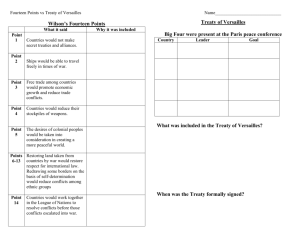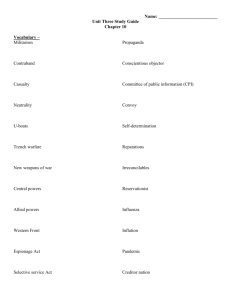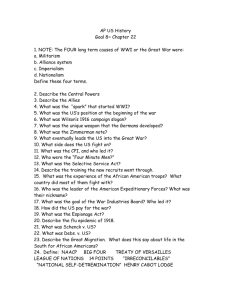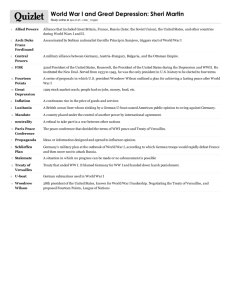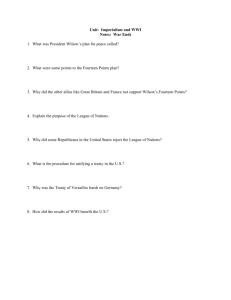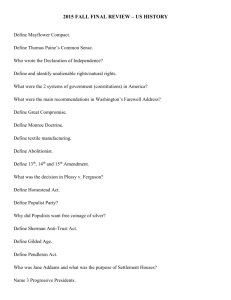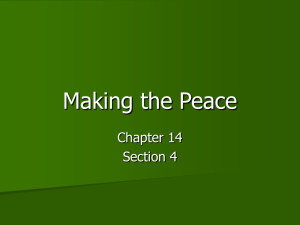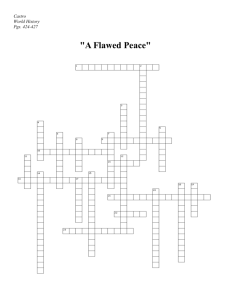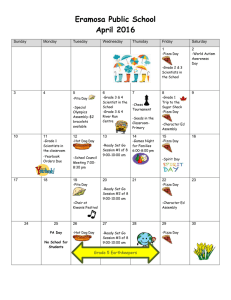Unit #2: Challenges of a New Century (1898
advertisement
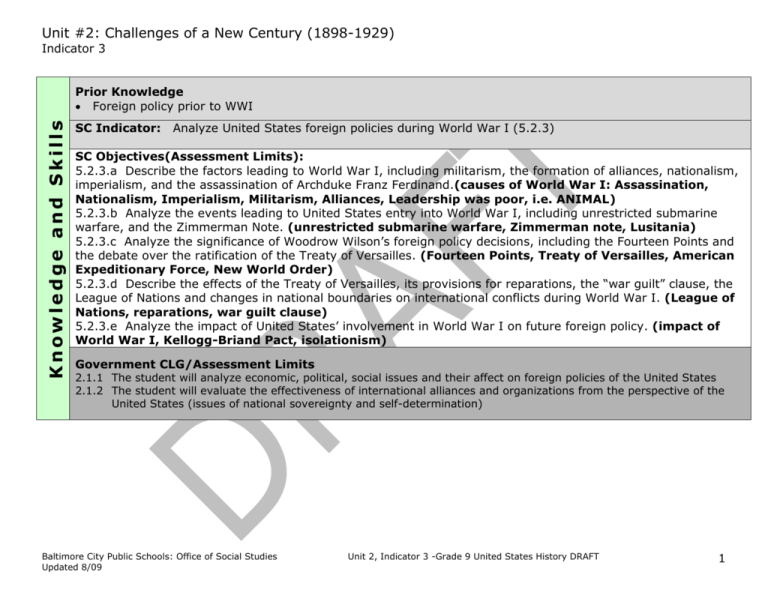
Unit #2: Challenges of a New Century (1898-1929) Indicator 3 Knowledge and Skills Prior Knowledge Foreign policy prior to WWI SC Indicator: Analyze United States foreign policies during World War I (5.2.3) SC Objectives(Assessment Limits): 5.2.3.a Describe the factors leading to World War I, including militarism, the formation of alliances, nationalism, imperialism, and the assassination of Archduke Franz Ferdinand.(causes of World War I: Assassination, Nationalism, Imperialism, Militarism, Alliances, Leadership was poor, i.e. ANIMAL) 5.2.3.b Analyze the events leading to United States entry into World War I, including unrestricted submarine warfare, and the Zimmerman Note. (unrestricted submarine warfare, Zimmerman note, Lusitania) 5.2.3.c Analyze the significance of Woodrow Wilson’s foreign policy decisions, including the Fourteen Points and the debate over the ratification of the Treaty of Versailles. (Fourteen Points, Treaty of Versailles, American Expeditionary Force, New World Order) 5.2.3.d Describe the effects of the Treaty of Versailles, its provisions for reparations, the “war guilt” clause, the League of Nations and changes in national boundaries on international conflicts during World War I. (League of Nations, reparations, war guilt clause) 5.2.3.e Analyze the impact of United States’ involvement in World War I on future foreign policy. (impact of World War I, Kellogg-Briand Pact, isolationism) Government CLG/Assessment Limits 2.1.1 The student will analyze economic, political, social issues and their affect on foreign policies of the United States 2.1.2 The student will evaluate the effectiveness of international alliances and organizations from the perspective of the United States (issues of national sovereignty and self-determination) Baltimore City Public Schools: Office of Social Studies Updated 8/09 Unit 2, Indicator 3 -Grade 9 United States History DRAFT 1 Unit #2: Challenges of a New Century (1898-1929) Indicator 3 VOCABULARY Imperialism Reparations “War Guilt” Clause Zimmerman Note Treaty of Versailles Fourteen Points Nationalism ENDURING UNDERSTANDINGS The role of the United States as a world power ESSENTIAL QUESTIONS What responsibility should the United States assume as a world power? Vocabulary Activities Baltimore City Public Schools: Office of Social Studies Updated 8/09 Unit 2, Indicator 3 -Grade 9 United States History DRAFT 2 Unit #2: Challenges of a New Century (1898-1929) Indicator 3 LEARNING ACTIVITIES AND STRATEGIES Suggested Learning Plan VSC Objective: Activity Description Textbooks: America: History of Our Nation: pages 706-708 Call to Freedom (CTF): pages 325-328 History Alive!: pages 283-285 United States History: Reconstruction to Present: pages 282-284 5.2.3.a Describe the factors leading to World War I, including militarism, the formation of alliances, nationalism, imperialism, and the assassination of Archduke Franz Ferdinand 5.2.3.b Analyze the events leading to United States entry into World War I, including unrestricted submarine warfare, and the Zimmerman Note Materials/Resources Teaching With Documents: The Zimmerman Telegram Lesson Plan (National Archives) Baltimore City Public Schools: Office of Social Studies Updated 8/09 Students analyze primary sources to identify the impact of the Zimmerman Telegram on the American public and government policy. National Archives: http://www.archives.gov/educatio n/lessons/zimmermann/ Unit 2, Indicator 3 -Grade 9 United States History DRAFT 3 Unit #2: Challenges of a New Century (1898-1929) Indicator 3 Textbooks: America: History of Our Nation: pages 708-711 Call to Freedom (CTF): pages 329-335 History Alive!: pages 286-291 United States History: Reconstruction to Present: pages 287-291 Textbooks: America: History of Our Nation: pages 721-726 Call to Freedom (CTF): pages 344-349 History Alive!: pages 315-323 United States History: Reconstruction to Present: pages 301-309 5.2.3.c Analyze the significance of Woodrow Wilson’s foreign policy decisions, including the Fourteen Points and the debate over the ratification of the Treaty of Versailles 5.2.3.d Describe the effects of the Treaty of Versailles, its provisions for reparations, the “war guilt” clause, the The Great War: Evaluating the Treaty of Versailles Lesson Plan Baltimore City Public Schools: Office of Social Studies Updated 8/09 By studying a variety of primary sources, maps, and supporting documents concerning the post-war peace process, students will develop a context for evaluating whether the treaty was viable and fair. Edsitement: http://edsitement.neh.gov/view_l esson_plan.asp?id=424 Unit 2, Indicator 3 -Grade 9 United States History DRAFT 4 Unit #2: Challenges of a New Century (1898-1929) Indicator 3 League of Nations and changes in national boundaries on international conflicts during World War I Textbooks: America: History of Our Nation: pages 725-726 Call to Freedom (CTF): pages 344-349 United States History: Reconstruction to Present: pages 301-309 5.2.3.e Analyze the impact of United States involvement in World War I on future foreign policy Textbooks: America: History of Our Nation: pages 725-726 Call to Freedom (CTF): pages 344-349 United States History: Reconstruction to Present: pages 301-309 DIFFERENTIATION Accommodations G.A.T.E./Enrichment Baltimore City Public Schools: Office of Social Studies Updated 8/09 Unit 2, Indicator 3 -Grade 9 United States History DRAFT 5


